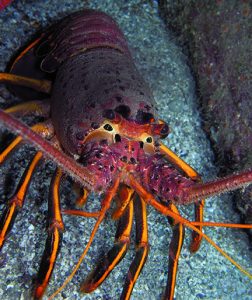 You’ve got to love those dive sites that can satisfy all skill levels. Hen Rock is just one of those locations. Reef and sand bottom depths vary from around 15 to 85 feet on the outer pinnacles. And there is no shortage of things to see and do.
You’ve got to love those dive sites that can satisfy all skill levels. Hen Rock is just one of those locations. Reef and sand bottom depths vary from around 15 to 85 feet on the outer pinnacles. And there is no shortage of things to see and do.
Swim-throughs, schools of fish, mini-walls and overhangs — sounds like an advanced dive site, doesn’t it? It’s not. Hen Rock is one of the best beginner dive sites at Catalina Island. It has a lot of fun reefs to explore with abundant life, most in shallow water.
A jumble of car-sized boulders make up the labyrinth of the main inner reef with most diving in just 15 to 35 feet of water. Passages include a moderately long tunnel under an arch formed by a huge rock sitting atop a few smaller boulders, a narrow causeway with deep overhangs on either side and yet another swim-through with a 90 degree turn half way through. You’ll have to spend a fair amount of time looking for these features but with shallow depths, a tank of air lasts a long time.
Dancing over the reefs are schools of blacksmith fish, and shoals of silvery jack mackerel and even barracuda. When you see barracuda, keep an eye out for giant black sea bass lurking underneath, as barracuda is one of their favorite foods. There are a lot of sheephead but alas they are all small.
A bit closer to the rocks, giant kelpfish will hide among the marine algae, blending in as if they are part of the undergrowth. A keen eye will spot them but they can be hard to follow as they duck for cover. Other reef fish include rockfish, thousands of colorful blue-banded gobies, and occasionally an exceptionally large calico bass holed up in one of the reef’s many small caves.
The invertebrate life is not too shabby either. Lobsters are quite abundant. As a matter of fact, this is one of the better lobster hunting spots in the area, when in season of course.
Along the deeper portions of the reef, the Spanish shawl nudibranch can be found displaying its distinctively bright blue-purple and orange colors. Gorgonian sea fans sway in the gentle surge. Here and there are stars including the red fragile star. Other critters include hermit crabs, decorator crabs, chestnut cowries and a variety of snails.
As much as the reef can be fun, be sure to spend some time over the sand. Bat rays are often encountered. Look for round holes in the sand about the size of half-dollar as these are the lairs of the shy mantis shrimp. They are colorful and entertaining to watch. Sheep crabs are always here looking like spiders crawling across the bottom.
With all the great diving here you’d think there is a kelp forest. Well there is, sometimes. As of late it has been thin or non-existent. But there was a time not too long ago when it was thick and lush. If history is any indication it may return in the near future as cooler waters return.
Conditions at Hen Rock are very consistent. Lying behind the protection of Long Point to the southwest, waters are generally calm. With little current, light winds and a solid sand bottom, it is easy to anchor if you are bringing a private vessel over to the island. Water clarity is generally good, averaging 40 feet.
And for the intermediate to advanced diver there are small outer reefs in 50 to as much as 85 feet of water. Beautiful stands of gorgonian decorate these rock pinnacles.
Hen Rock rarely disappoints. It offers good quality diving with a lot to see with easy conditions.
At-A-Glance
Skill Level: All.
Location: Just to the southeast of Long Point on the front side of Catalina Island. GPS N 33°24.051’, W 118°21.984’
Access: Boat only.
Entry and Exit: Easy off boat as conditions are almost always calm.
Depth Range: 15 to 85 feet.
Conditions: Excellent where waters are almost always very calm.
Visibility: Good averaging a consistent 40 feet.
Photography: Good wide-angle with varied reef structure and occasionally a kelp forest.
Hunting: Generally poor. Sometimes you might find a fair sized calico bass or occasionally a legal sized lobster early in the season.
Cautions: Boat traffic.







